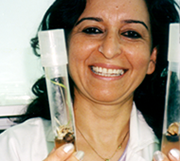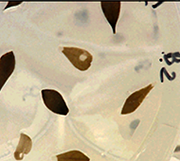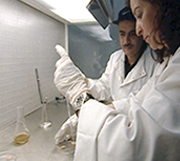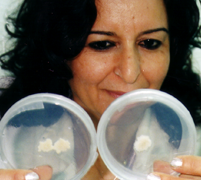Jordan - The Science

Efforts are underway to preserve the Badia's native plants and unlock their secrets by mining age-old folk medicine with the tools of twenty-first century science.
University of Jordan botanist Dr. Sawsan Oran is part of a team of scientists conducting medical research on native plants. The work is supported by The Jordan Badia Research and Development Program, backed by Jordan's Higher Council for Science and Technology.
I suggest we put in the clip from the final edited program of the Princess talking.
Her Highness Sharifa Zein bint Nasser provides active support for these efforts. "We don't work behind desks. We don't work behind fences. We are there with the people for the people. We want to explore but we don't want to exploit and that I think it's the difference. What you have is truly a treasure. What you have, its not very available everywhere. There is great potential, for economical development through the plant and plant cultivation. Don't forget the important thing here. It is that we are not teaching anything new or totally different. It is not something out of the culture. It is something that needs lot of training or expensive training."
As a part Jordan's efforts to preserve their diminishing medicinal plants, Dr. Oran has for decades cataloged and preserved the wild plants of her homeland. She sees beauty and possibility in the more than four thousand varieties of plants that she has found to date. She says, "I noticed that about 40% of these plants are medicinal. I know our ancestors used those plants for treatment. This has encouraged us as researchers to look for the specific active compounds."
Dr. Oran and her colleagues believe important clues might lie in Arabic folk medicine still practiced by the Bedouins, or Bedu, as they call themselves. Tribal nomads, the Bedu proudly trace their lineage back to Ishmael, son of Abraham.
While out in the field, Dr. Oran seeks out local people and traditional healers to find out how the various plants are used. The medicinal uses of these plants have been tested and refined over thousands of years by these local people.
Dr. Oran then brings these plants back her lab to be catalogued and studied. She is excited about helping to discover the potential of what she calls Jordan's "wild medicinal wealth."
She established the university's herbarium that now has more than 4,000 different species identified and labeled by their Latin botanical name. The plants are treated to protect them from damage and decay, then preserved and stored for anyone who wants to learn about this rich resource. The herbarium also has a seed gene bank to ensure that this national heritage can be fully developed in the future.
Through genetic processes in the lab, Dr. Oran works to save these plants from extinction and possibly even develop some plants into possible commercial crops.
In a sterile tissue culture room, Dr. Oran and her colleagues are finding ways to grow many new plants from tiny seeds, pieces of leaves, or simple root tissue. The plant matter is grown in a nutrient medium in Petri dishes under laboratory conditions. When all goes well, a tissue mass called a callus develops. This callus is then treated with hormones so it will differentiate in a further stage into the different parts of the plant - the leaf, the flowers, and the root system.
From one small fragment of a bulb, for example, Dr. Oran can develop three or four plantlets. Once the plants have reached a certain stage in the lab, they are ready to be acclimatized and planted outdoors.
Dr. Oran and her co-workers hope to reestablish the plants, such as the black iris, in areas of the Jordanian desert where they have vanished.
The black iris, for example is not just only a beautiful dark purple flower, but it also has medicinal potential. But although it has long been used in folk medicine, it is the scientific processes that will make it available to a wider basis.
In her lab, Dr. Oran runs experiments of many plants, testing their seeds, parts of their flowers or their roots. She may take parts of the leaf or the comb or rhizome and put it in the grinder, take the powder. Then she puts it in boiling water and waits until the precipitate comes down to the bottom of the test tube. This liquid contains the active chemical compound. It is then sent to the university chemist for further identification and analysis.
Read more about her finding with specific plants in The Plants section.

Dr. Oran, an internationally published scientist in the area of medicinal plants

Through modern tissue culture processes Dr. Oran can grow a complete plant from just a leaf.

Today, 65% of cancer drugs come from plant sources. Dr. Oran is working with plants showing anti-leukemia properties

The start of a new plant through tissue culture
For more information about this website.
Contact the webmaster to report any problems with this site.
New Mexico State University is an equal opportunity/affirmative action employer and educator. NMSU and the U.S. Department of Agriculture cooperating.